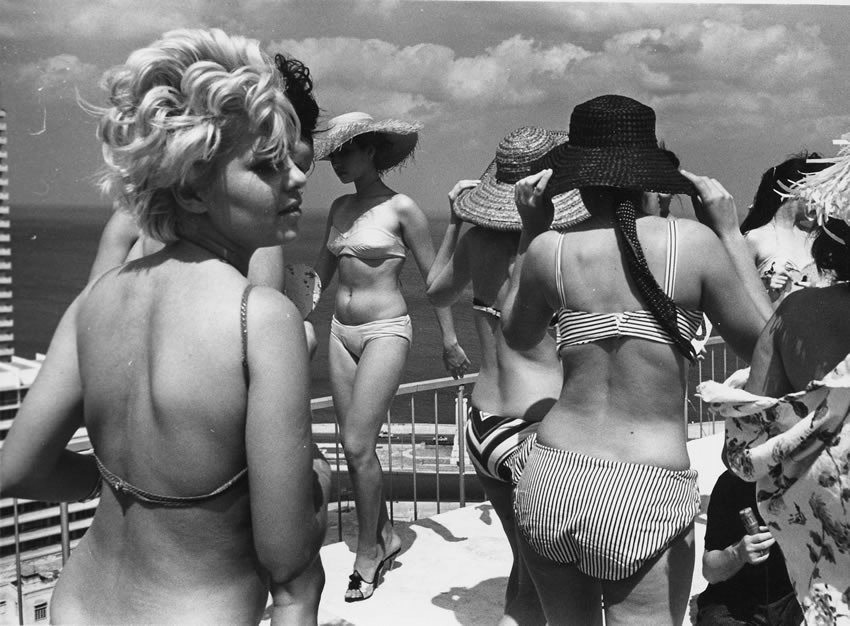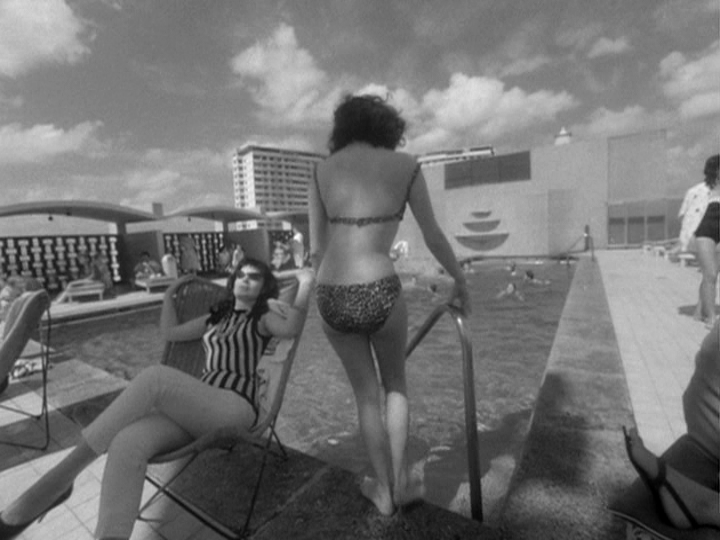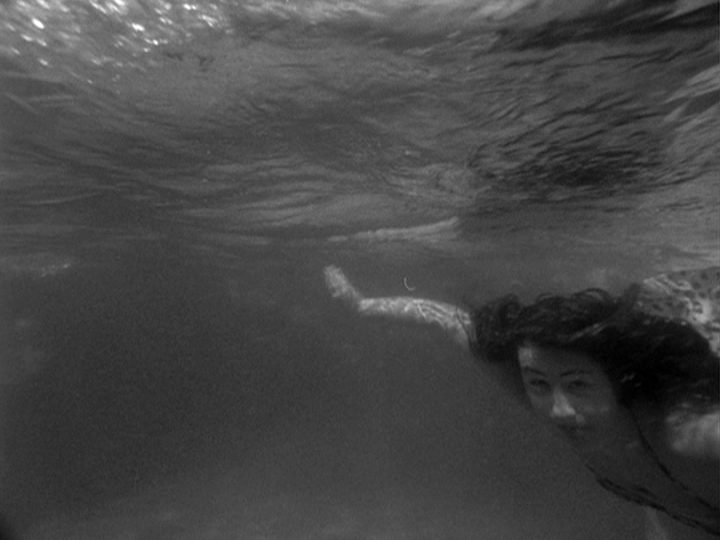From the Chicago Reader (December 8, 1995). — J.R.
I Am Cuba
*** (A must-see)
Directed by Mikhail Kalatozov
Written by Yevgeny Yevtushenko and Enrique Pineda Barnet
With Luz Maria Collazo, Jose Gallardo, Sergio Corrieri, Maria Gonzalez Broche, Raul Garcia, and Jean Bouise.
Undeniably monstrous and breathtakingly beautiful, ridiculous and awe inspiring, I Am Cuba confounds so many usual yardsticks of judgment that any kind of star rating becomes inadequate. A delirious, lyrical, epic piece of communist propaganda from 1964 — at least three years in the making and 141 minutes long–it is simply too campy and too grotesque to qualify as a “masterpiece,” but I’d probably care less about it if it were one. A “must-see” may come closer to the mark, but it certainly isn’t a must-see for everybody. This movie has been rattling around in my head since I first encountered it 16 months ago, yet I can’t say it won’t enrage some people and bore others. Worth seeing? Has redeeming facet? Worthless? It fits all and none of these categories. To put it simply, the world doesn’t make allowances for a freak of this kind.
A Russian-Cuban production, it reportedly was hated in Russia and Cuba alike in the mid-60s, at least among government officials; in Cuba it was commonly known as I Am Not Cuba. Apparently it wasn’t seen anywhere else until the 1992 Telluride film festival, where an unsubtitled print was shown as part of a tribute to director Mikhail Kalatozov.
It’s being presented jointly now by Francis Ford Coppola and Martin Scorsese, but one can’t readily lump it with the other art-house classics they’ve helped to distribute. It does frequently remind one of two celebrated unfinished features about Latin America by gifted outsiders, Sergei Eisenstein’s Que Viva Mexico (which was studied by the director and writers of I Am Cuba during preproduction) and Orson Welles’s It’s All True (unavailable for study until a couple of years ago), but since these films were never completed they don’t define a tradition this movie can belong to (at most they suggest the sort of sensual fantasies foreigners are apt to have about South Americans and Central Americans). Started before the Cuban missile crisis, I Am Cuba also harks back to such episodic revolutionary epics as Eisenstein’s Potemkin and Pudovkin’s Deserter, as well as to historically inspired portmanteau features like Rossellini’s Paisan. But the baroque style of I Am Cuba may ultimately and paradoxically come closer to that of Disney’s The Three Caballeros, made in 1945.
Auteurism is as much of a problem here as star ratings; it’s not clear that Kalatozov is the individual most responsible for the film’s distinctiveness. Judging from its unique, shimmering black-and-white look and the recent testimony of its cowriter, Russian poet Yevgeny Yevtushenko, the film belongs mainly to its cinematographer, the extraordinary Sergei Urusevsky (1908-1974), but I have no way of confirming this impression. (Urusevsky shot the two other Kalatozov films I’ve seen, The Cranes Are Flying from 1957 and The Letter Never Sent from 1960, the second a hallucinatory tale about four geologists hunting for diamonds in the Siberian taiga that’s said to have influenced Andrei Tarkovsky and the Coppola of Apocalypse Now; The Letter Never Sent was roundly criticized by its production unit as formalist, though it still packs a punch.)
A couple of other oddities about I Am Cuba are worth noting — one linguistic, the other visual. The dialogue and narration are mainly in Spanish, apart from a few lines in English (coming mainly from characters designated as American tourists and sailors). There’s also a Russian voice-over that translates the Spanish and English, and English subtitles that translate the Russian and Spanish, with the result that most of the English lines you hear are different from the ones you read: when an American tourist in a decadent Havana nightclub says “I’ll take a limeade,” this is duly translated into Russian, and the Russian line is then subtitled “A soft drink for me.”
The film’s visual style closely resembles Orson Welles’s in many particulars: low and tilted angles, lengthy and highly expressive camera movements, high-contrast chiaroscuro, and the use of a wide-angle lens to create spatial distortion in the foreground of shots and deep focus in the background. Yet if one compares I Am Cuba to the feature that Welles was making in Europe at the same time, The Trial (1962), the differences in meaning are vast. There’s a much closer match between I Am Cuba and Welles’s 1958 Touch of Evil — ironically a film denounced in Russia for its “decadence,” most notably by director Sergei Yutkevich. In part this resemblance can be attributed to the fact that all of the action in Touch of Evil is set in and around a Mexican border town; and if one compares the use in both pictures of a jazzy kind of rock music to suggest corruption and seediness, one might even say that their puritanism is quite similar.
The parallels between Welles’s camera style and I Am Cuba’s are especially intriguing from an ideological standpoint. Welles remained a leftist (mainly of the currently disparaged “liberal” variety) throughout his career, yet most popular appreciations of his work, Citizen Kane in particular, tend to be right-wing celebrations of headstrong individualism — an individualism in which an expressive camera style is always read as personal, individualized expression — triumphing over collective effort. The fact that the notorious formalism of I Am Cuba was attacked in both Cuba and Russia in the 60s might mean that it’s actually a conservative movie in disguise. But it’s much likelier that our Yankee capitalist reflexes may force us to read collective work in individualist/auteurist terms even when they don’t apply, and give up on a puzzle like I Am Cuba when it fails to yield the usual auteurist rewards.
Let’s start with the aforementioned sense of decadence near the beginning of I Am Cuba, which makes such a strong impression that the remainder of the movie never quite recovers from it. Our first taste of it comes after a couple of gorgeous sequences introduce us briefly to the topography of Cuba and to some poor people living in a village. The second sequence is a veritable theme-park ride down a picturesque tropical stream with a boatman, past huts on stilts where children play and women wash their clothes, and it introduces us to a formalism that more or less remains throughout the picture, quickly becoming its most troubling and fascinating aspect. After this sequence there’s an abrupt cut to a jazzy rock band blasting away on a rooftop overlooking the Havana beaches while numerous bathing beauties stroll by — the basic material for a breathtaking sequence without any cuts — followed by a sequence purportedly set in a Havana nightclub. In both of these extended accounts of Yankee corruption during the late Batista period the film is just as two-faced as Larry Clark’s recent Kids in clucking its tongue at nasty revels it can’t get enough of. If anything, it’s even more appreciative of what it’s showing than Clark’s film — which makes it more fun to look at, though harder to process as a communist movie, at least until one arrives at the end of the sequence. As the camera moves several stories down to applauding tourists around an outdoor swimming pool — lingering over a pretty blond woman in a dress who’s being handed a drink, then abandoning her to follow a poolside bathing beauty into the water — we’re clearly on another theme-park ride. Then, when the camera (and the accompanying sound) goes even further and dips with the bather below the water’s surface, we’re arguably entering a realm closer to the sex-crazed cartoons of Tex Avery. Back in 1965 Urusevsky tried to justify this delirious move thematically in relation to the previous village sequence: “Taking the camera into the pool is justified because water is the visual link between the two scenes,” he wrote. I assume he was being just as sincere as some American reviewers were last summer when they described the teenage sex scenes in Kids as some kind of “aesthetic” breakthrough.
We next move to the nightclub, where Ignacio — the falsetto lead for the Platters during the 50s — is singing in Spanish about “this crazy love in my blood.” A den of iniquity where bamboo poles suggest prison bars and large wooden idols make us think of barbaric rites, this nightmarish cavern with its elaborate Afro-Cuban floor show and prostitutes at the bar introduces us to three male tourists implausibly identified as Americans. The most prominent of these, Jim, who has a fetish for crucifixes, is played by French actor Jean Bouise, later known for his performances in La guerre est finie, The Conformist, Out 1, and Z.
In a subsequent sequence we see Jim take one of the prostitutes back to her shack in the Havana ghetto (a hut that oddly resembles a Russian constructivist sculpture); in the morning he insists on purchasing her crucifix, which she doesn’t want to sell. As he walks away through the crowded ghetto, accompanied by the sound of a humming male voice and a solo guitar, the tilted camera, starting from a birdcage he passes, cranes up the full height of a telephone pole, while a woman designated as the “voice of Cuba” in the credits intones, “I am Cuba. Why are you leaving? You came here to have fun. Go ahead, have fun! Isn’t this a happy picture? Don’t avert your eyes. Look, I am Cuba. For you, I am the casino, the bar, the hotels and brothels. But the hands of these children and old people are also me. I am Cuba.”
This, I would maintain, is less hypocritical and more socially responsible than what we get in Kids — even if it comes from a discredited ideology and two discredited countries and has to build its polemic around a view of Americans that’s every bit as caricatured as our view of Russians during the same period. It even strives to set up a dialectical relationship with its previous appreciation of the rooftop revels and the nightclub — getting us to identify with the tourists and then undermining that identification — a process Clark’s film, with its beady-eyed voyeurism, never comes close to attempting. But in current economic parlance, I Am Cuba doesn’t belong in our cultural vocabulary because it invests all its aesthetic capital in a bad business venture. I guess that means it must be wrong, no matter how good it looks.
There are three more extended sequences in I Am Cuba. The first shows us a sugarcane harvester learning that his brutal boss has sold his land to the United Fruit Company and that he has to vacate his house; sending his son and daughter into town, he burns the sugarcane field and his house to the ground before collapsing in defeat.
In Havana we follow the adventures of Enrique, a radical student who saves a woman from a band of drunken American sailors, reads in the paper that Fidel Castro is dead, meets with his comrades, and prepares to assassinate a fat police officer who killed many of his friends, though he loses his nerve at the last minute. Then the police raid a room where students are printing pro-Castro leaflets, and one of the protesters is shot. A crowd gathers, and Enrique addresses it until another shot rings out and a white dove falls. Holding the dead bird aloft like a flag, Enrique leads the crowd, now singing the Cuban national anthem, into the street, where they’re met with water hoses. Shot by the fat cop, Enrique becomes a revolutionary martyr, and as a funeral cortege follows his body through downtown Havana, the camera, in one take, cranes all the way up the side of a building, crosses the street, passes through a cigar-rolling factory, returns to the street through another window, and then continues to follow the cortege from an aerial view for what seems like a good quarter of a mile. (A partial explanation of how this astonishing shot was achieved is offered by the cameraman, Alexander Calzatti, in the July 1995 issue of American Cinematographer; it required a “special cable device” that Calzatti built in Moscow before coming to Cuba.)
The final — and least memorable — sequence follows various rebel soldiers fighting and regrouping in the mountains as well as one peasant family dodging bombs and seeing their home demolished; the husband tells his family he has to join the rebel forces and winds up singing the Cuban anthem with them.
Throughout much of the film Urusevsky and his skilled camera crew (three of whom are billed in the credits simply for “pyrotechnics”) use infrared film stock that makes palm trees and sugarcane look as white as sun-soaked sheets — an astonishing visual effect that mythologizes the Cuban landscape, making it an appropriate setting for dreams. An estimated 97 percent of the film was shot with handheld cameras; though the early rooftop sequence may seem to be the work of one frenzied individual, it was actually carried out by a relay team of three separate camera operators — a good example of collective work in action. In fact, much of the handheld camera work throughout feels personal without being individualized, an apt reflection of the film’s poetic and political agenda.
In an unfinished 1955 essay reevaluating Russian silent films by Eisenstein, Pudovkin, and Dovzhenko, Robert Warshow found these films reprehensible because of their aesthetic distinction. Given the usual American mistrust of art, it’s a telling confession: “It was not at all an aesthetic failure that I encountered in these movies, but something much worse: a triumph of art over humanity. It made me, for a while, quite sick of the art of the cinema, and sick also of those people who sat with me in the audience, mes semblables, whom I suspected of being either cinema enthusiasts or Communists — and I wasn’t always sure which was worse.”
He could have been writing about I Am Cuba — a triumph of art over humanity, he might have said, except that it wasn’t regarded as any sort of triumph when it appeared in Cuba and Russia 30 years ago. Given that art is a human activity, how can it be said that it triumphs over humanity? Perhaps what he meant was that a film like I Am Cuba aestheticizes (and therefore disrespects) human suffering. But then in what way could Hollywood celebrations of human slaughter — routinely accepted as entertainment — be regarded as morally preferable?
Warshow, I should stress, was writing during the darkest part of the cold war, when the demonizing of Russians went well beyond the mythologizing of palm trees, sugarcane, and peasant poverty. At his best he showed an intellectual grasp of the theoretical implications of film style that surpassed that of his contemporaries James Agee and Manny Farber, but tragically cold-war paranoia made him as much of a Neanderthal as an anti-intellectual Hollywood director like Leo McCarey. (To read Warshow’s attack on McCarey’s great if deranged 1952 anticommunist movie My Son John is to encounter two brilliant sensibilities in hapless collision, thanks to a shared political mindset that ultimately made everyone who shared it dishonorable.)
Forty years after Warshow’s antiart and anticommunist invective, at a time when the communist menace has become a bad dream or camp joke of the past, it would be comforting to say that this sort of intolerance has been tempered by historical hindsight and a more balanced perspective. But alas, our continuing reliance on demonology suggests that our minds are often still living in the cold war even if our bodies are not. This means that we’re still unequipped to separate the wheat from the chaff when it comes to a bewildering mixture of art and propaganda like I Am Cuba; our first impulse may be to reject it all as egregious nonsense. Yet for all its excesses, I Am Cuba has plenty of accurate things to say about Cuba under Batista.
I don’t want to deny that a certain amount of egregious nonsense is there. But it’s no less present in the 1947 testimony of Alice Rosenbaum (better known by her American name, Ayn Rand) to the House Un-American Activities Committee that Russians under communism never smile (“If they do, it is privately and accidentally. Certainly, it is not social”). In the final analysis this nonsense is in the cold-war culture shared by Russia and the U.S. rather than in some bacterium belonging to one side and not the other. The fact that McCarey’s My Son John remains woefully unavailable on video is as symptomatic of our shortsightedness as the indigestibility of I Am Cuba. What we could learn from these two amazingly poetic and terminally wrongheaded movies is incalculable; they’d make a dream double feature.











